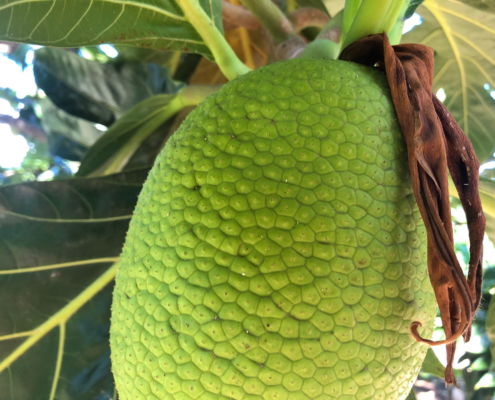
Breadfruit Trees
What Is Breadfruit?
One of the most important plants (known as “canoe plants”) brought to Hawai’i by the ancient voyaging Polynesians is the breadfruit tree. This beautiful tree played a major role in colonizing the Pacific and was a key staple food. For hundreds of years before western contact with Hawai’i this fruit tree, called ulu, was a large part of the cultural and spiritual life of ancient Hawaiians. Ancient Hawaiian breadfruit groves were so large that some were capable of sustaining around 75,000 people! These trees were also an important source of wood, craft materials and medicines. Today few of these trees remain in Hawai’i compared to ancient times.
Anthropologists now know that Polynesians colonized the Pacific 1000 years before Columbus crossed the Atlantic ocean. The area of the Pacific ocean traveled by these seafaring peoples is larger than all the landmass on earth combined. How did they do it? By bringing with them plants and animals that could sustain a colony in newly found lands. Archeological evidence shows that this advanced and highly sophisticated society arrived in Hawai’i sometime between 250 A.D. and 450 A.D. and began to develop an agricultural system that would eventually support hundreds of thousands of people by the time western explorers arrived in the late 1700’s.
Breadfruit Tree Facts
Breadfruit trees are one of the highest yielding food plants known. A single tree can produce between 50 to 150 fruits per year (yield varies between wet and dry areas) and their round, oval or oblong fruits can weigh as much as 12 pounds!
Breadfruit trees can grow to a height of 85 ft and all parts of the tree yield a latex sap which is useful as a sealant such as for canoe caulking. It’s light sturdy timber was used for canoe outriggers and house construction.
The Many Uses Of Hawaiian Breadfruit Trees
As a Food Source
This extremely versatile fruit can be prepared and eaten in all stages of development and maturity, ripe as a fruit or mature as a vegetable. Today mature fruits are used for most dishes due to the breadfruits potato-like texture.
Nutrition
Breadfruit is gluten free and packed with nutrients. It was one of several “super foods” in ancient times (along with taro & coconut) that enabled the Hawaiians to colonize the eight main Hawaiian islands with what may have been close to 1 million people!
Breadfruit is high in carbohydrates and a good source of antioxidants, calcium, carotenoids, copper, dietary fiber, energy, iron, magnesium, niacin, omega 3, omega 6, phosphorus, potassium, protein, thiamine, vitamin A and vitamin C. Breadfruit also contains some carotenoids and lutein which is not present in white rice or white potato. A ½ cup of breadfruit provides 25% of the RDA for fiber and 5 to 10% of the RDA for protein, magnesium and potassium. As the fruit ripens starches convert to sugars and the fruit softens to a custard like consistency. This sweet custard can be eaten raw.
Breadfruit Preparations & Recipes
Think of breadfruit as a tropical potato. It tastes fantastic mashed, in salads, made into french fries and chips and in countless other dishes where you can use potato – except it’s more nutritious than potatoes!
According to the National Breadfruit Institute of Hawai’i there are many ways to prepare mature breadfruit: steamed, boiled, fried, baked, or cooked in traditional ways in a fire. It can then be used in a variety of dishes such as casseroles, fritters, pancakes, breads, curries, stews, chowders, salads and many other dishes. It can also be mashed and made into dips, like hummus, or vegetarian burgers or pâté.
Popular breadfruit dishes in Hawai‘i include: salad (like potato salad), curry, cooked in coconut cream, chips, chowder, nachos, and with corned beef. When breadfruit ripens it becomes soft and creamy and sweet. At this stage it can be eaten raw or used to make beverages, baked goods, desserts like flan, and other sweet dishes.
Immature green fruit, from golf ball size to almost full size, can be cooked entire, or cut into thin slices or chunks and boiled until tender. Once cooked, they can be eaten with dips, used in salads, and marinated, or pickled. The flavor and texture resembles artichoke heart. Traditional methods of cooking ‘ulu are roasting directly on a fire until the skin blackened and the flesh was tender, baking in the imu (underground oven), and pounding into a doughy consistency (for poi or other uses).
A modern twist involves putting cooked ‘ulu from the imu or boiled/ steamed, through a food processor and adding a little bit of coconut oil to give it a smooth texture. This type of preparation can be used like dough, rolled out for pasta, pizza, or tamales. Another way to use breadfruit is to peel and core the raw fruit, shred or slice it into thin pieces, then dry and grind it into a meal or flour. The coarse meal can substitute for panko or breadcrumbs. Since the flour is gluten free, it will not rise or have the elasticity of wheat flour, but can be used like other gluten-free flours.
Other Uses Of Breadfruit
Not Just a Food Source
Not just a substantial food source, the breadfruit tree also provides a multitude of other advantageous uses.
Gluten-Free Flour: Breadfruit can be processed into a gluten-free flour, far superior in taste, nutrition and structure to any other GF flour alternative.
Insect Repellant: In addition to being a safer alternative to DEET, the male breadfruit flower is highly effective at repelling mosquitoes and other insects.
Latex: The sap excreted from the breadfruit can be used as a waterproof caulking for watercrafts and homes, as well as chewing gum.
Fabric: Fibers from the bark of the breadfruit tree can be harvested without killing the crop and used to make mosquito nets, clothing, accessories, artwork and even paper.
Animal Feed: Fallen fruits, as well as the leaves of the tree, can be used as nutritious animal feed.
Western Discovery Of Breadfruit
Breadfruit is believed to have originated in New Guinea and the Indo-Malay region and was spread throughout the vast Pacific by voyaging islanders. Europeans discovered breadfruit in the 1500s and were amazed and delighted by a tree that produced prolific, starchy fruits that, when roasted, resembled freshly baked bread.
This prolific tree has hundreds of known varieties of breadfruit in our world today and more yet to be recorded. Trees produce fruit that look completely different when compared to other growers and gardens, ranging from dark green and weighing as much as a watermelon, to lavender color and apple-sized. Leaves are long and slender with deep, curving lobes to wide and round with barely any lobes at all.
April 28th, 1789 marks one of the most infamous events in history that happened all because of breadfruit: The Mutiny on the Bounty. Still fascinating more than two centuries later, the story includes a mutiny, a grand sailing adventure pitting men against the sea, and a reviled captain whose name is synonymous with tyranny and pettiness.
Sir Joseph Banks, who sailed on HMS Endeavour with Captain Cook to Tahiti in 1769, recognized the potential of breadfruit as a food crop for other tropical areas. He proposed to King George III that a special expedition be commissioned to transport breadfruit plants from Tahiti to the Caribbean. He is quoted as saying:
“regarding food, if a man planted 10 (breadfruit) trees in his life he would completely fulfill his duty to his own as well as future generations…”
This set the stage for one of the grandest sailing adventures of all time. The ill-fated voyage of HMS Bounty in 1787, under the command of Captain William Bligh, is an extraordinary tale of mutiny, deceit, courage, and sailing skill.
Mutiny On The Bounty Is About Breadfruit?
Here is one account of the first botanical voyage to obtain breadfruit trees in the south Pacific:
When the Bounty eventually reached her destination of Tahiti on October 25 1788 she had covered 27,000 miles and had been at sea 10 months. In view of the slanders that have been written about Bligh’s “brutal” treatment of his crew it is worth noting that in that time only two men had been flogged – one with 24 lashes for mutinous behavior and one six lashes for neglect of duty – and that all on board except for a drunken doctor were as fit and well as when they had left England.
As a result of her late arrival the Bounty had missed the proper season for transplanting and five months passed before the gardeners were able to collect and take aboard a full cargo of more than 1,000 young breadfruit trees. In that time most of the crew acquired Tahitian mistresses, and had become so enchanted with life on the islands that they were reluctant to leave.
When the Bounty sailed on April 4 1789 Bligh was completely unaware of the undercurrent of discontent, and could never have dreamed that it would explode into mutiny.
Early next morning, April 28, Bligh was wakened by his first mate Mr Christian and several others who came into his cabin armed with bayonets. Bligh was abused and threatened, his hands were tied behind him, and he was forced up onto the deck clad only in his shirt. It was not until he saw several others under arrest that he realized a mutiny was actually taking place. He demanded to know the reason for it and was told to keep quiet or he would be killed. All he could get from Christian was “I have been in hell for the last fortnight, sir – in hell”.
The ship’s launch, 23 feet long and 6 feet 9 inches wide, was hoisted out. Sails, ropes, 32 lb of pork, 150 lb of biscuit, a 28-gallon cask of water, and 6 quarts of rum were loaded into her. Bligh and 18 others including the gunner, boatswain and sailmaker were ordered aboard. She was so heavily laden that her gunwales cleared the water by only seven inches, and many personal possessions which had been stowed in her had to be jettisoned. Bligh asked for arms, but the mutineers laughed at him. Finally four cutlasses were thrown aboard and the launch was cast adrift.
Bligh and his companions agreed that their only chance was to reach Timor, 3,600 miles away, with stops at various islands on the way to replenish food and water supplies. Their first stop was at Tofoa, one of the Friendly Islands, the morning after they had been cast adrift. Far from being friendly, however, the natives pelted them with volleys of stones, killing one man and chasing the launch out to sea.
It was obvious that without firearms the same risk could not be taken again. So plans were changed. A direct course was set for Timor and food and water were strictly rationed. Only Bligh’s dogged resolution kept them going during the next three weeks. The weather was atrocious with heavy rainstorms and gale-force winds whipping up mountainous seas. They hardly slept at all, and for days on they were never dry. Their daily ration was two ounces of ship’s biscuit and a little water. Occasionally a mouthful of pork was added, and now and then Bligh issued a ration of rum.
On May 24 the Great Barrier Reef was sighted ahead and they knew they were near the north-eastern coast of New South Wales (now Queensland). They had decided to bypass Botany Bay, the expected site of the new colony, because at this time Bligh was unaware of whether the First Fleet had yet arrived and how successful the enterprise had been. Four days later, inside the reef they landed on an uninhabited island where they found water and a good supply of shellfish. Several days were spent on various islands recouping their strength, and on June 3 they rounded Cape York and sailed west for Timor.
Eleven days later they rounded the Dutch port of Koepang so exhausted and starving that they could barely crawl ashore. They had covered 3,618 miles in 41 sailing days, a feat almost without parallel, and a remarkable tribute to Bligh’s tenacity, navigational skill and seamanship. It is ironic that the long voyage had claimed only one life and that as a result of native hostility, whereas a short stay in Koepang had claimed the lives of three of Bligh’s crew, all from fever. Eastern ports in those days were notoriously infested places.
For his second breadfruit voyage in 1791 Bligh was given two ships, HMS Providence and a tender, the Assistant. Learning from his earlier experience he made no mistake this time and in due course 544 plants were landed in the Caribbean at Kingstown, St. Vincent, and another 633 at various places in Jamaica. All were in splendid condition. As a reward Bligh received from the planters of St. Vincent a piece of plate valued at 100 guineas, and the Jamaican House of Assembly voted him 1,000 guineas. The breadfruit thrived in their new environment, but the West Indians never really took to them and would eat them only when other food was unobtainable.
The amazing feat of navigating thousands of miles across open ocean to colonize some 10,000 islands is a testament to the skill and bravery of ancient Polynesians. The breadfruit tree is but one legacy of these ingenious people and their canoes that carried them and all they needed to survive across 1/3 of the earths surface. If you see one of these trees or it’s fruit while visiting Hawai’i remember that it has traveled with and nourished the Hawaiian people for close to 1000 years!
Aloha Nui Loa








